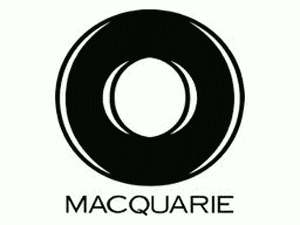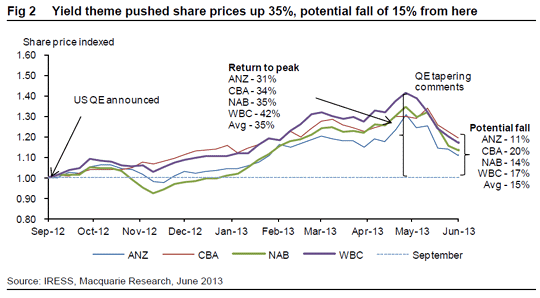
By Gareth Vaughan
With talk of the US Federal Reserve tapering off its massive quantitative easing (QE) programme, the dividend yield-driven rise in the share prices of the big Australasian banks may be over, analysts at Macquarie suggest.
Macquarie's Sydney-based analysts Michael Wiblin, Stephen Wood and Elisa DiMarco note a 35% rise in the share prices of ASB's parent Commonwealth Bank of Australia, BNZ's parent National Australia Bank, the ANZ Banking Group and Westpac Banking Corporation post the start of the Fed's QE III programme last September. The Fed is buying US$45 billion in long-term Treasury bonds and US$40 billion of mortgage-backed securities monthly, as it tries to boost the US economy by pushing down long-term interest rates to encourage borrowing, spending and hiring.
However, with financial markets undergoing a shift as investors speculate on the Fed tapering off its QE programme, the Macquarie analysts note the big banks share prices have fallen over the past month, and probably have further to go.
"As highlighted in our note 'Value is in the eye of the beholder' on April 4, we believed the sector was overvalued by as much as 30%+ in some areas. Since then the sector has pulled back by around 20%. Clearly a worst case 'pre-QE' scenario could see a further drop in share prices of around 15%," the Macquarie analysts suggest.
In a low interest rate environment the Aussie banks have been attractive to investors because they pay out the bulk of their profits in dividends. There have also been special dividends and share buybacks. As of yesterday afternoon, CBA was trading on a dividend yield of 5.5%, ANZ 5.4%, Westpac 5.9%, and NAB 6.3%.
The surge in big Aussie bank share prices has seen CBA's market capitalisation surge above A$100 million making it one of the 10 biggest banks in the world by market cap and bigger than all of Germany's banks combined. In fact, at the end of April the big four Aussie banks were all among the world's top 11 banks by market cap, but ANZ and NAB have since dropped down, leaving CBA at six and Westpac ninth (see UBS charts at the foot of this story).
CBA CEO Ian Narev told interest.co.nz in March there were forces in the equity markets that suited the profile of CBA's stock.
"Which is globally there is a low interest rate environment, you've got investors searching for yield. They're searching for yield with equity stocks with defensive characters," Narev said.
"CBA and the other major banks in Australia are attractive. That is creating a dynamic underpinning the performance of the stock at the moment. Do we expect that dynamic to continue for ever? Of course not. Can I say when it's going to end, what's going to happen after it? I don't know and you can't manage the bank to that."
Meanwhile, the Macquarie analysts note the big four banks have seen both earnings and dividend upgrades of about 7% since QE III's launch, and their cost of equity has dropped 75 basis points.
All else being equal, they suggest this means there should be a rise in share prices of about 10%.
"As a result the sector appears fair value, not 15% overvalued," Wiblin, Wood and DiMarco suggest.
"While our view at the start of the crisis had been that the new normal trading range for the sector had been between 9x to 11x (price to equity ratio), the recent yield based run has seen the sector trade well above these levels."
"In the mean-time, with rates continuing to decline, we believe the cost of equity for the sector has also declined to be around 75 basis points below the old equilibrium level. This coupled with a low growth outlook (2-4% growth) means that the new trading range for the sector is likely to be 10-12x."



This article was first published in our email for paid subscribers. See here for more details and to subscribe.

We welcome your comments below. If you are not already registered, please register to comment.
Remember we welcome robust, respectful and insightful debate. We don't welcome abusive or defamatory comments and will de-register those repeatedly making such comments. Our current comment policy is here.